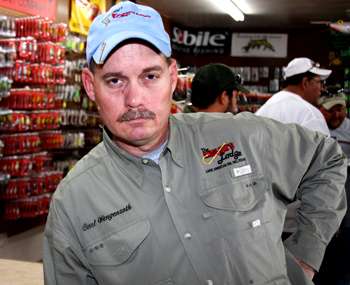
If you’re serious about catching big bass — really big bass — there’s a tackle manufacturer out there you need to know. His name is Carl Wengenroth. He owns and operates RiverSlung Custom Lures and The Anglers Lodge and Tackle Shop in Del Rio, Texas, just down the road from Lake Amistad.”As a serious tournament fisherman in south Texas, I know that if you don’t catch big bass you go home without a check,” says Wengenroth. “My partner and I were frustrated with tiny finesse baits or fishing with whatever we could find in tackle shops. To be blunt, we were tired of getting beat.”I knew the guys who were winning were throwing big stuff, most of it homemade. I decided to follow their lead and make a few custom plastic baits for big bass. I started in my garage with a hotplate and a tin cup and everything has grown from there.””Grown” has a dual meaning to this big bass specialist. In one sense he’s referring to his business. From its tiny beginnings, RiverSlung has expanded into a serious player in the big bass bait market with customers all over the world.In another sense, however, he’s talking about the physical size of his baits. His biggest lures now include straight-tail worms from 12 to 21 inches, curled-tail worms up to 20 inches, a 5-inch crawdad and creature baits in the 11-inch range.Making a plastic bait that big isn’t as easy as it sounds, as Wengenroth quickly discovered. If they’re too supple, they’ll break. If they’re too stiff, they won’t catch fish. He solved that problem by mixing soft, freshwater plastic with tough, saltwater material.And then there’s the salt issue. Salt is popular with anglers and fish alike. But it makes plastic heavy, which causes it to lie on its side in the water. That’s not popular with anglers or fish. Wengenroth opted to pour without salt. He feels it’s more important that the lure stand up and display a lifelike action than to be impregnated with salt.”When you put one of our big baits on, you’re only looking for one thing — the biggest bass in the lake or river. These are not numbers lures; they’re designed to get you one or two of the biggest bites you’ve ever had. Size and lifelike action are what matter the most.Our smaller stuff will catch numbers. But we’re primarily a big bait, big fish company. Everything we do is aimed at catching giant bass. That’s what we started out to do and what we want to keep doing. Giant bass is a relative term, however. A giant in Texas, California or the Deep South is well over 10 pounds. The 21-inch straight-tail Giant Earthworm is fine for something of that size. But go to the Midwest, or almost anywhere else for that matter, and giant has another definition — 6 or 7 pounds.Will a 6-pounder really eat a 21-inch worm, or an 11-inch creature bait named Frankenstein? Wengenroth says they will. He relates stories of anglers who regularly catch bass as small as 4 pounds on his biggest baits and bass as small as a pound on his smaller lures.”We have reports that they work really well everywhere as long as you’re looking for a big bite — 5, maybe 6 pounds. Of course, regardless of where you fish my baits you’re going to get a lot of tail nibblers and that sort of thing.”The babies just can’t handle something that big, but they can’t resist messing with them either. That’s something you’ll just have to get used to if you’re going to go big. Besides, the little jerks and taps keep you on your toes.”Rigging one of these giant baits isn’t as difficult as you might expect. The biggest worms are typically rigged with Owner hooks in the 7/0 to 11/0 size range and held down with tungsten weights. The bigger creature baits are often rigged on specially molded jig heads from Xcite Baits.”Hook size is especially important. Everybody thinks we use them because the bass are big, but that’s not the real reason. You need a big hook so you don’t break the worm in two when you cast it. A smaller hook puts too much weight behind the hook, which causes the bait to flex on the cast and break into two pieces.”If you want to follow Wengenroth’s advice and go big this summer, you can get everything you’ll need from RiverSlung Custom Lures. They have a Web site (www.riverslung.com), but you can’t order online just yet. Instead, call him at 830-775-1763 or reach The Angler’s Lodge at 830-775-1586. He’ll be more than happy to talk trophy bass fishing with you, help you make the right lure and terminal tackle selections and ship you everything you need.
And, if you happen to have a bait you’d like to upsize, he can do that as well … just as long as the design isn’t patented or otherwise legally protected.




